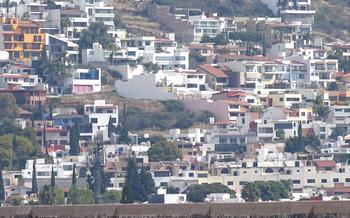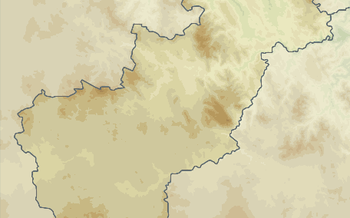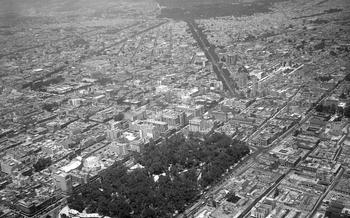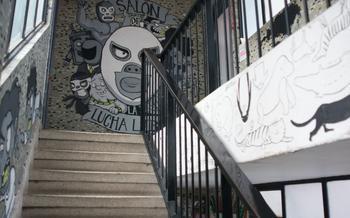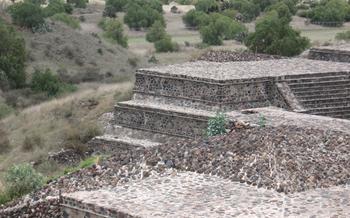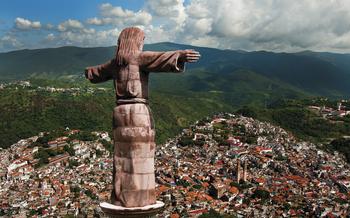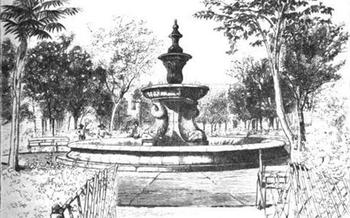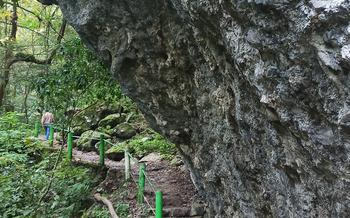
Neptune Fountain
- Neptune Fountain: A Symbol of Queretaro's History
- Admire the Architectural Masterpiece
- Explore the Alameda Central Garden
- Take a Leisurely Walk
- Capture the Perfect Photo
- Learn about Queretaro's History
- Experience the Vibrant Nightlife
- Enjoy Local Delicacies
- Visit Nearby Attractions
- Shop for Souvenirs
- Interact with the Locals
- Plan Your Accommodation
- Transportation and Accessibility
- Insider Tip: Hidden Gems
Neptune Fountain: A Symbol of Queretaro's History
The Neptune Fountain stands proudly in the heart of Queretaro's Alameda Central Garden, a symbol of the city's rich history and cultural heritage. Built in 1797, this magnificent fountain was commissioned by the Marques de la Villa del Villar del Aguila, a wealthy landowner who wanted to create a grand centerpiece for the city's main square.
The fountain's design is a testament to the Baroque and Neoclassical architectural styles popular in 18th-century Mexico. Sculpted from pink tezontle stone, the fountain features an intricate arrangement of mythological figures, including Neptune, the Roman god of the sea, surrounded by tritons, nereids, and other aquatic creatures.
Located in the heart of the historic center, the Neptune Fountain is surrounded by colonial-era buildings, lively cafes, and bustling shops. It serves as a gathering place for locals and visitors alike, who come to admire its beauty, relax in the shade of the surrounding trees, and soak up the vibrant atmosphere of this historic city.
Admire the Architectural Masterpiece
The Neptune Fountain stands as a testament to the artistic prowess and cultural significance of Queretaro. Its unique features and design elements set it apart from other fountains worldwide. The central figure of Neptune, the Roman god of the sea, is depicted with intricate detail, his powerful presence commanding attention. The surrounding sculptures, representing various mythological figures and creatures, add to the fountain's grandeur and symbolism.
The fountain's design showcases a harmonious blend of European and Mexican artistic styles. The Baroque influence is evident in the elaborate ornamentation and dramatic gestures of the sculptures, while the indigenous Mexican motifs add a unique touch to the overall design. The intricate carvings and reliefs on the fountain's base depict scenes from mythology and nature, inviting viewers to explore the rich symbolism and allegorical meanings hidden within the artwork.
Throughout the years, the Neptune Fountain has undergone meticulous restoration and preservation efforts to maintain its original beauty and integrity. These efforts have ensured that this architectural masterpiece continues to stand as a proud symbol of Queretaro's cultural heritage and artistic legacy.
Explore the Alameda Central Garden
The Alameda Central Garden, where the Neptune Fountain stands tall, is a testament to Queretaro's rich history and vibrant culture. Established in the 17th century, this urban oasis has served as a gathering place for locals and visitors alike for generations. With its lush greenery, tranquil fountains, and impressive sculptures, the garden offers a serene escape from the hustle and bustle of city life.
Strolling through the Alameda Central Garden is a delightful experience. The air is filled with the sweet fragrance of flowers, and the sound of birdsong creates a calming atmosphere. The garden's well-manicured lawns invite you to relax and soak up the peaceful ambiance. As you wander along the paths, you'll encounter a variety of sculptures and fountains, each telling a unique story about Queretaro's past.
The Alameda Central Garden is not just a beautiful green space but also a vibrant cultural hub. Throughout the year, the garden hosts a variety of events and activities that showcase Queretaro's rich traditions. From concerts and art exhibitions to traditional dance performances and food festivals, there's always something happening in the Alameda Central Garden.
Take a Leisurely Walk
The Neptune Fountain and the Alameda Central Garden are best experienced on foot. Visitors can take their time to admire the fountain's intricate details, stroll through the garden's lush greenery, and soak in the tranquil atmosphere.
The garden features a network of walking paths and trails that wind their way through the park, offering a variety of routes for a leisurely stroll. Visitors can choose to follow a specific path or simply wander aimlessly, enjoying the serenity and tranquility of the surroundings.
The best time to visit the fountain and garden is during the early morning or late afternoon, when the sun is not too harsh and the temperatures are more pleasant. During these times, visitors can take a leisurely walk without having to worry about the heat or crowds.
To make the most of your walk, it is advisable to wear comfortable shoes and bring along a bottle of water, especially if visiting during the warmer months. Visitors can also bring a camera to capture the beauty of the fountain and the garden, or simply relax on one of the many benches and enjoy the peaceful atmosphere.
Capture the Perfect Photo
The Neptune Fountain and the Alameda Central Garden provide a picturesque backdrop for capturing stunning photographs. To capture the fountain's grandeur, position yourself at a slight distance to include both the fountain and the surrounding garden in your frame. Experiment with different angles to highlight the fountain's intricate details and sculptures.
For the best lighting conditions, visit during the golden hours of sunrise or sunset when the warm light casts a magical glow on the fountain and garden. Utilize a tripod or smartphone stabilizer to ensure sharp and steady shots, especially when capturing long exposures or panning shots.
Don't limit yourself to daytime photography; the fountain takes on a different charm at night when it's illuminated. Experiment with night photography techniques, such as long exposure, to capture the vibrant colors and reflections of the fountain against the dark sky.
Share your stunning shots on social media using relevant hashtags to connect with other travelers and photography enthusiasts. Inspire others to explore the beauty of Queretaro and its iconic Neptune Fountain through your captivating images.
Learn about Queretaro's History
The Neptune Fountain is not merely an artistic masterpiece but also a significant landmark in Queretaro's historical tapestry. Its construction in 1907 marked a pivotal moment in the city's development and reflected the growing influence of European culture and aesthetics. The fountain's design and symbolism are deeply rooted in Queretaro's rich past, paying homage to the fusion of indigenous and colonial heritage that shaped the city's unique identity.
As you admire the fountain's intricate details, take a moment to reflect on the historical context that gave rise to its creation. Queretaro, once a small colonial town, underwent a period of rapid growth and transformation in the late 19th century. The city became a center for trade and commerce, attracting immigrants from various parts of Mexico and Europe. This influx of diverse cultures and influences left an indelible mark on Queretaro's architecture, cuisine, and traditions.
To delve deeper into the city's history, consider embarking on a guided tour or exploring historical walking trails that showcase other significant landmarks and monuments. These tours provide insightful narratives and anecdotes, allowing you to gain a comprehensive understanding of Queretaro's evolution from a colonial outpost to a vibrant and thriving metropolis.
Experience the Vibrant Nightlife
As the sun sets, the Neptune Fountain and its surroundings transform into a vibrant hub of activity. The fountain's illuminated waters create a mesmerizing spectacle, attracting locals and tourists alike. The nearby streets come alive with the sounds of music, laughter, and lively conversations.
A multitude of restaurants, bars, and cafes line the streets, offering a diverse range of culinary delights and entertainment options. From traditional Mexican cuisine to international flavors, there's something to satisfy every palate. Street performers showcase their talents, creating a festive atmosphere that permeates the air.
As the night progresses, the energy intensifies. Cultural events, such as concerts, dance performances, and art exhibitions, are often held in the Alameda Central Garden, adding to the vibrant atmosphere. The fountain serves as a backdrop to these events, creating a magical ambiance.
While exploring Queretaro at night, safety is of utmost importance. Stick to well-lit areas, be aware of your surroundings, and avoid walking alone. Taxis and rideshare services are readily available for safe transportation.
Enjoy Local Delicacies
Indulge in the culinary delights of Queretaro, where traditional Mexican cuisine meets regional specialties. Savor the flavors of mouthwatering tacos, enchiladas, and tamales, all prepared with fresh, local ingredients. Don't miss the iconic street food of Queretaro, such as gorditas and carnitas, which offer a taste of the city's vibrant street culture.
For an authentic dining experience, head to the bustling markets near the fountain, where you can sample a variety of local dishes at affordable prices. Be sure to try the traditional Queretaran dish of enchiladas queretanas, known for its unique green sauce and cheese filling.
If you're looking for a more upscale dining experience, there are several restaurants in the area that offer a sophisticated take on Mexican cuisine, using seasonal ingredients and modern culinary techniques. Whether you prefer casual street food or fine dining, Queretaro's culinary scene has something to offer every palate.
For vegetarian and vegan travelers, there are plenty of options available. Many restaurants offer meat-free versions of traditional Mexican dishes, and there are also several dedicated vegetarian and vegan restaurants in the city.
No matter your dietary preferences, be sure to come hungry to Queretaro and embrace the opportunity to savor the city's delicious cuisine.
Visit Nearby Attractions
Beyond the Neptune Fountain and the Alameda Central Garden, Queretaro offers a plethora of other captivating attractions. Immerse yourself in history at the Regional Museum of Queretaro, housing pre-Hispanic artifacts and colonial art. Marvel at the architectural grandeur of the Templo de Santa Rosa de Viterbo, a 17th-century church renowned for its intricate facade and stunning interior frescoes.
For a unique cultural experience, visit the Museo del Juguete Antiguo Mexico (Museum of Antique Mexican Toys), showcasing an impressive collection of traditional toys from various regions of Mexico. Art enthusiasts will delight in exploring the Museo de Arte de Queretaro, featuring both classical and contemporary Mexican artworks.
Venture beyond the city center to discover the charming nearby towns and villages. Bernal, a picturesque town known for its iconic monolith, offers breathtaking views and opportunities for hiking and rock climbing. Tequisquiapan, famous for its natural hot springs and vineyards, invites you to relax and indulge in wine tasting.
To make the most of your time, plan a comprehensive itinerary that allows you to seamlessly blend historical exploration, cultural immersion, and scenic adventures. With so much to offer, Queretaro promises an unforgettable experience for every traveler.
Shop for Souvenirs
At the Neptune Fountain, you can discover a treasure trove of unique handicrafts and souvenirs inspired by its rich history and cultural significance. Stroll through the vibrant local markets and artisan shops surrounding the fountain to find authentic pieces that capture the essence of Queretaro. From intricate pottery and colorful textiles to hand-carved wooden sculptures and traditional jewelry, there's something for every taste and budget.
Engage with the local artisans and learn about their creative process as they demonstrate their skills. Don't hesitate to bargain for the best prices, as it's a customary practice in Mexican markets. By purchasing souvenirs, you not only take home a piece of Queretaro but also support the local economy and the talented artisans who create these beautiful works of art.
Interact with the Locals
Experience the warmth and hospitality of Queretaro's residents as you explore the city. Engage in friendly conversations, share stories, and learn about their culture. Embrace the opportunity to practice your Spanish, even if it's just a few basic phrases. The locals will appreciate your effort and be happy to assist you.
Participate in cultural exchanges to gain a deeper understanding of Queretaro's traditions and way of life. Visit local markets, attend community events, or join a cooking class. These experiences will provide you with unique insights into the city's rich heritage.
Build connections and lasting memories with the people you meet. Share a meal, exchange contact information, or simply take a moment to appreciate the kindness and generosity of the locals. These interactions will make your trip to Queretaro truly unforgettable.
Plan Your Accommodation
To make the most of your visit to the Neptune Fountain and the surrounding area, it's essential to choose the right accommodation. Several hotels and guesthouses are located within walking distance of the fountain, offering convenience and easy access to the city's attractions.
If you're looking for a budget-friendly option, there are several hostels and budget hotels that provide comfortable and affordable accommodations. It's advisable to book in advance, especially during peak tourist seasons, to secure your preferred room and avoid disappointment.
When selecting your accommodation, consider factors such as location, price, and amenities. If you're traveling on a tight budget, consider staying in a hostel or a budget hotel farther from the city center. If you prefer more comfort and convenience, opt for a hotel near the fountain or in the historic district.
Additionally, ensure that the accommodation you choose is accessible if you have any mobility challenges. Many hotels in Queretaro offer accessible rooms and facilities for individuals with disabilities.
Overall, planning your accommodation in advance will help ensure a comfortable and enjoyable stay in Queretaro, allowing you to fully immerse yourself in the city's history, culture, and attractions.
Transportation and Accessibility
Reaching Queretaro is a breeze, with multiple transportation options available. Queretaro Intercontinental Airport (QRO) offers convenient connections to major cities worldwide. Alternatively, you can take a scenic bus ride or embark on a road trip through the picturesque Mexican countryside. Once in the city, exploring is a breeze. Public transportation, including buses and taxis, is reliable and affordable, allowing you to reach the Neptune Fountain and other attractions with ease. For those seeking more flexibility, renting a car is an excellent choice. Queretaro is also committed to accessibility, ensuring that individuals with disabilities can navigate the city comfortably. Designated parking spaces, ramps, and accessible public transportation options are widely available. Whether you prefer to stroll, ride, or drive, Queretaro welcomes you with open arms and ensures a seamless and enjoyable visit.
Insider Tip: Hidden Gems
Beyond the popular tourist spots, Queretaro offers a treasure trove of hidden gems waiting to be discovered. Just a short walk from the Neptune Fountain, you'll find the Templo de Santa Rosa de Viterbo, a beautiful 18th-century church with intricate Churrigueresque architecture. For a unique perspective of the city, head to the Cerro de las Campanas, a hilltop park with panoramic views and historic monuments.
For a taste of local culture, visit the Mercado La Cruz, a traditional market selling everything from fresh produce to handmade crafts. The nearby Museo de la Ciudad (City Museum) offers a glimpse into Queretaro's rich history and cultural heritage. And for a fun evening out, don't miss the Teatro de la República, where you can catch a performance of traditional Mexican music and dance.
Remember, the best way to discover Queretaro's hidden gems is to venture off the beaten path, interact with the locals, and ask for their recommendations. Embrace the spirit of exploration, and you'll be rewarded with unforgettable experiences that will make your trip truly special.
